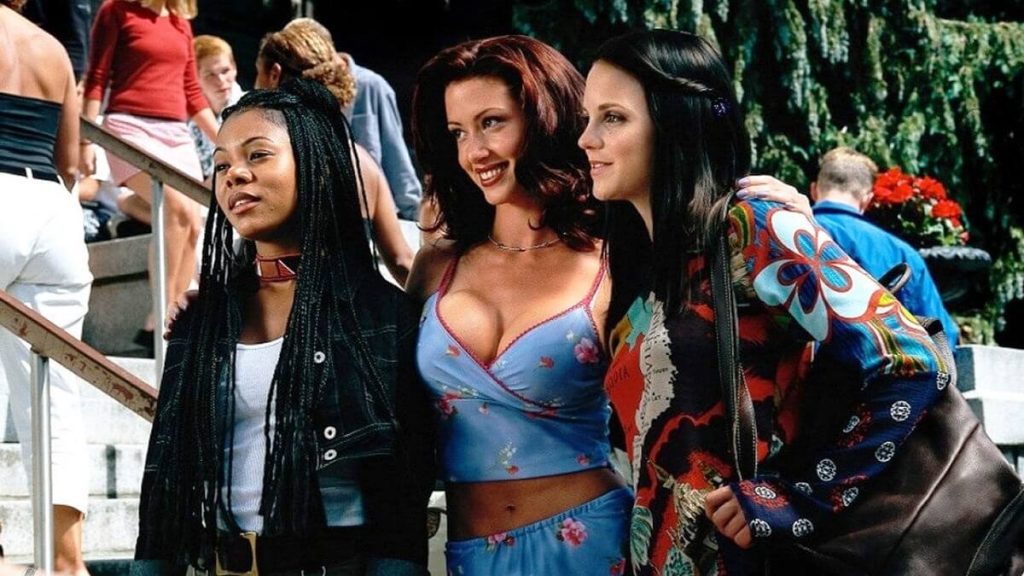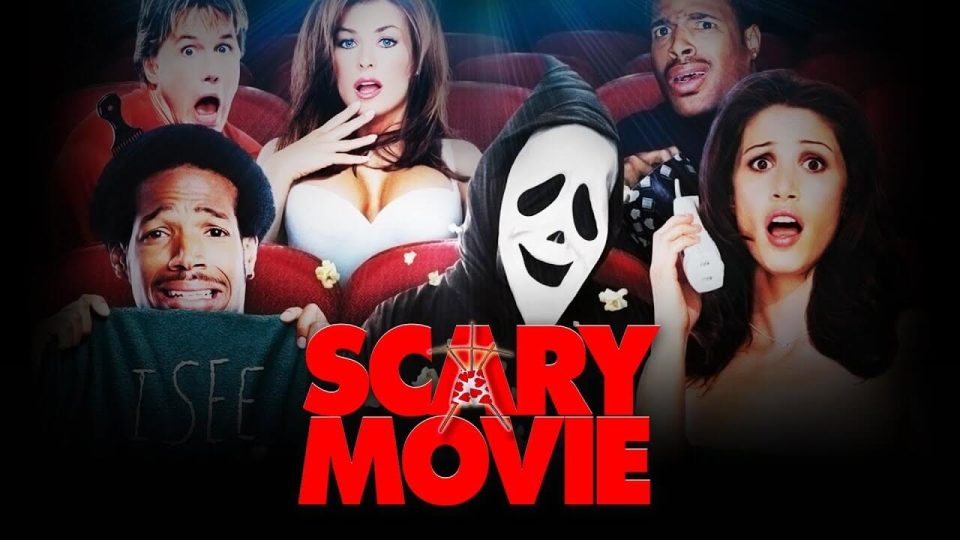In 2000, “Scary Movie” redefined comedy horror by parodying iconic horror films with irreverent humor, influencing future parodies and comedies. It satirized well-known horror tropes with a star-studded cast, blending slapstick comedy and sharp wit for a unique experience. We’ll explore its plot, performances, themes, and legacy to see how it set new standards for parody films and comedic storytelling.
How “Scary Movie” Poked Fun at Iconic Horror Films (Plot Overview)
“Scary Movie,” released in 2000, is a horror-comedy film that cleverly satirizes the conventions of iconic horror films. The plot centers around a group of teenagers who find themselves being stalked by a mysterious killer, offering a comedic twist on the classic slasher narrative.
The movie primarily parodies well-known horror films like “Scream” and “I Know What You Did Last Summer,” with its storyline closely mirroring that of “Scream.” In fact, the film’s opening sequence is a direct parody of the infamous first scene from “Scream,” featuring an unsuspecting victim receiving ominous phone calls before meeting her demise in an absurdly humorous fashion.
Throughout its plot, “Scary Movie” weaves together elements from various horror genres, blending them into a cohesive yet hilariously exaggerated narrative. The film pokes fun at typical horror tropes such as inept police officers, clueless victims, and the predictability of killer reveals. It also incorporates other pop culture references and comedic subplots to enhance its parody nature.
By combining slapstick humor with sharp wit, “Scary Movie” successfully delivers both laughs and scares while paying homage to (and simultaneously lampooning) the beloved horror films it draws inspiration from. Its unique blend of parody and comedy has earned it a place as one of the standout entries in the genre of horror-comedy.
The Cast and Their Performances
The 2000 film “Scary Movie” brought together a remarkable cast that delivered unforgettable comedic performances, transforming the horror genre with a satirical twist. Leading the ensemble was Anna Faris, who made her debut in this film and became synonymous with the role of Cindy Campbell. Faris’s portrayal was both endearing and hilarious, showcasing her knack for blending comedy with horror elements seamlessly.
Central to the film’s success were also the Wayans brothers, Shawn and Marlon Wayans, who not only starred in but were instrumental in writing and producing “Scary Movie.” Their unique brand of humor was pivotal in parodying classic horror tropes while adding layers of wit and absurdity that resonated with audiences. The Wayans brothers’ comedic timing and chemistry on screen ensured that “Scary Movie” was not just another spoof but a standout entry in its own right.
The rest of the cast contributed significantly to this star-studded ensemble. Each actor brought their own flair to their roles, enhancing the overall comedic impact of the film. By cleverly subverting expectations typical of horror films through exaggerated performances and sharp dialogue, they collectively redefined what audiences could expect from a comedy within this genre.
Main Themes and Satire in “Scary Movie”

“Scary Movie,” released in 2000, is a prime example of how comedy and horror can blend to create a unique cinematic experience. At its core, the film is a satire that cleverly pokes fun at the conventions of the horror genre. By analyzing the main themes and satirical elements, we can better understand how “Scary Movie” uses humor to both entertain and critique.
One of the primary themes in “Scary Movie” is the subversion of traditional horror tropes. The film takes well-known scenarios from classic horror films and exaggerates them to absurdity, highlighting their inherent ridiculousness. This approach not only provides laughs but also encourages audiences to question why these tropes have become so ingrained in horror storytelling.
The satire in “Scary Movie” extends beyond just mocking individual films; it targets broader themes within comedy-horror films as well. For instance, it addresses issues such as gender roles and stereotypes often perpetuated by the genre. By exaggerating these elements, “Scary Movie” invites viewers to reflect on how these portrayals affect audience perceptions.
Moreover, analyzing comedy in horror movies like “Scary Movie” reveals how humor can be used as a tool for social commentary. The film’s parodying nature allows it to comment on societal fears and anxieties prevalent at its time of release, using laughter as a means to diffuse tension and provoke thought.
“Scary Movie” exemplifies how satire can be effectively employed within comedy-horror films to entertain while simultaneously critiquing cultural norms. Through its clever use of humor and parody, it challenges audiences to reconsider their understanding of both genres while providing an engaging cinematic experience that continues to resonate with viewers today.
Cinematic Techniques and Style
The fusion of comedy and horror in film is a delicate art that requires a keen understanding of both genres. One prime example of this blend is the cinematic style of the 2000 film “Scary Movie,” which expertly parodies classic horror tropes while infusing them with humor. To effectively parody a horror film, filmmakers often employ specific comedy techniques that play on audience expectations and subvert traditional genre elements.
One such technique is exaggeration, where typical horror scenarios are pushed to absurd extremes, highlighting their inherent ridiculousness. This approach not only generates laughs but also offers a fresh perspective on familiar scenes. For instance, in “Scary Movie,” exaggerated character reactions and over-the-top situations poke fun at the predictability often found in horror films.
Another technique is the use of irony and satire. By presenting characters who are self-aware or by directly referencing well-known horror clichés, filmmakers can create a meta-commentary that resonates with audiences familiar with the genre. This self-referential humor invites viewers to laugh at both the characters’ predicaments and their own knowledge of horror conventions.
Timing also plays a crucial role in blending humor with fear. Well-executed comedic timing can transform tension into laughter, as seen when suspenseful moments are abruptly interrupted by unexpected jokes or slapstick elements. This disruption not only provides comic relief but also keeps audiences engaged by constantly shifting emotional gears.
By incorporating these comedy techniques into their cinematic style, filmmakers can successfully parody horror films while maintaining respect for the original material. The result is an entertaining hybrid that celebrates both genres through clever storytelling and innovative visual gags.
Audience Reception and Critic Reviews at Release
The year 2000 marked a fascinating period for the film industry, especially in the realm of horror and comedy. Scary movies released during this time often evoked strong reactions from audiences, who were eager to experience thrills that combined suspense with innovative storytelling. The audience reaction to scary movies in 2000 was generally positive, with viewers appreciating the blend of traditional horror elements and fresh cinematic techniques that kept them on the edge of their seats.
Critically, these films received a mixed reception. While some critics praised the ingenuity and atmospheric tension crafted by filmmakers, others felt that certain releases relied too heavily on genre clichés or lacked depth in character development. Despite these critiques, many scary movies managed to carve out a niche for themselves within popular culture due to their ability to tap into universal fears and deliver genuine scares.
In contrast, comedies during this period experienced significant box office success. The lighthearted nature of comedic films provided audiences with much-needed relief from everyday stresses and an opportunity for laughter amidst more serious cinematic offerings. This success can be attributed to relatable humor, charismatic performances by leading actors, and engaging storylines that resonated with diverse demographics.
Overall, both genres demonstrated their unique appeal through audience reception and critical reviews at release. While scary movies continued to captivate thrill-seekers with their chilling narratives, comedies thrived as crowd-pleasers at the box office, proving once again the enduring allure of both fear-induced excitement and joyous laughter in cinema.
The Legacy of “Scary Movie”
The release of “Scary Movie” in 2000 marked a pivotal moment for the parody genre, setting a new standard for comedic films that followed. Its legacy is evident in how it reshaped the landscape of comedy, particularly influencing future parodies. The first installment of “Scary Movie,” with its sharp wit and fearless approach to lampooning the horror genre, demonstrated how parody could be both entertaining and commercially successful.
This film’s impact on comedy films post-2000s is significant. It opened doors for a wave of similar movies that sought to replicate its formula of blending satire with slapstick humor. By pushing boundaries and embracing absurdity, “Scary Movie” encouraged filmmakers to explore more daring comedic narratives. This influence is seen in subsequent films that not only targeted horror but also expanded into other genres like action and romance.
The legacy of the first “Scary Movie” installment lies in its ability to connect with audiences through relatable humor while simultaneously critiquing popular culture. It highlighted how parody could serve as both entertainment and commentary, inspiring future filmmakers to craft comedies that resonate on multiple levels. As we look back at its enduring influence, it’s clear that “Scary Movie” has left an indelible mark on the evolution of comedy films in the 21st century.
Why “Scary Movie” (2000) Remains a Must-Watch for Comedy Enthusiasts and Horror Fans Alike
“Scary Movie” (2000) remains a must-watch for both comedy enthusiasts and horror fans due to its clever blend of humor and homage to classic horror films. This parody successfully captures the essence of popular horror tropes while delivering laughs through its sharp wit and slapstick comedy. By poking fun at iconic scenes from movies like “Scream” and “I Know What You Did Last Summer,” “Scary Movie” not only entertains but also offers a unique perspective on the genre.
The film’s ability to balance satire with genuine affection for its source material is a testament to its enduring appeal. It cleverly deconstructs the clichés that define horror, making it accessible for those who might typically shy away from the genre while still offering plenty of in-jokes for seasoned fans. The ensemble cast, featuring memorable performances by Anna Faris and Marlon Wayans, adds another layer of enjoyment, bringing their comedic talents to the forefront.
Furthermore, “Scary Movie” set a precedent for future parodies by demonstrating how humor can be used as a tool to critique and celebrate film genres simultaneously. Its success paved the way for subsequent entries in the franchise, solidifying its place in cinematic history as an influential work that continues to resonate with audiences today. Whether you’re seeking laughter or looking to revisit familiar horror themes with a comedic twist, “Scary Movie” offers an experience that’s both entertaining and insightful.
